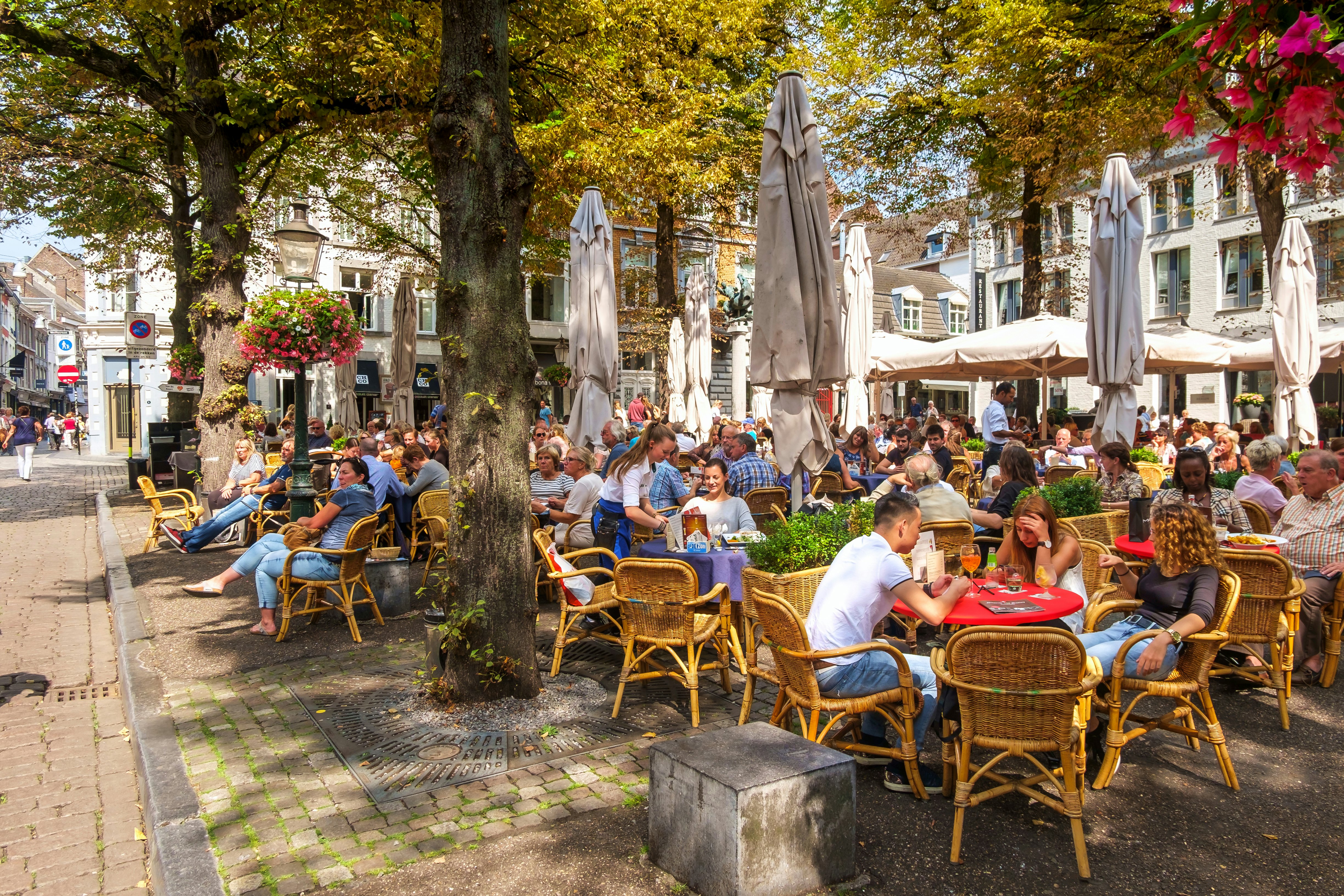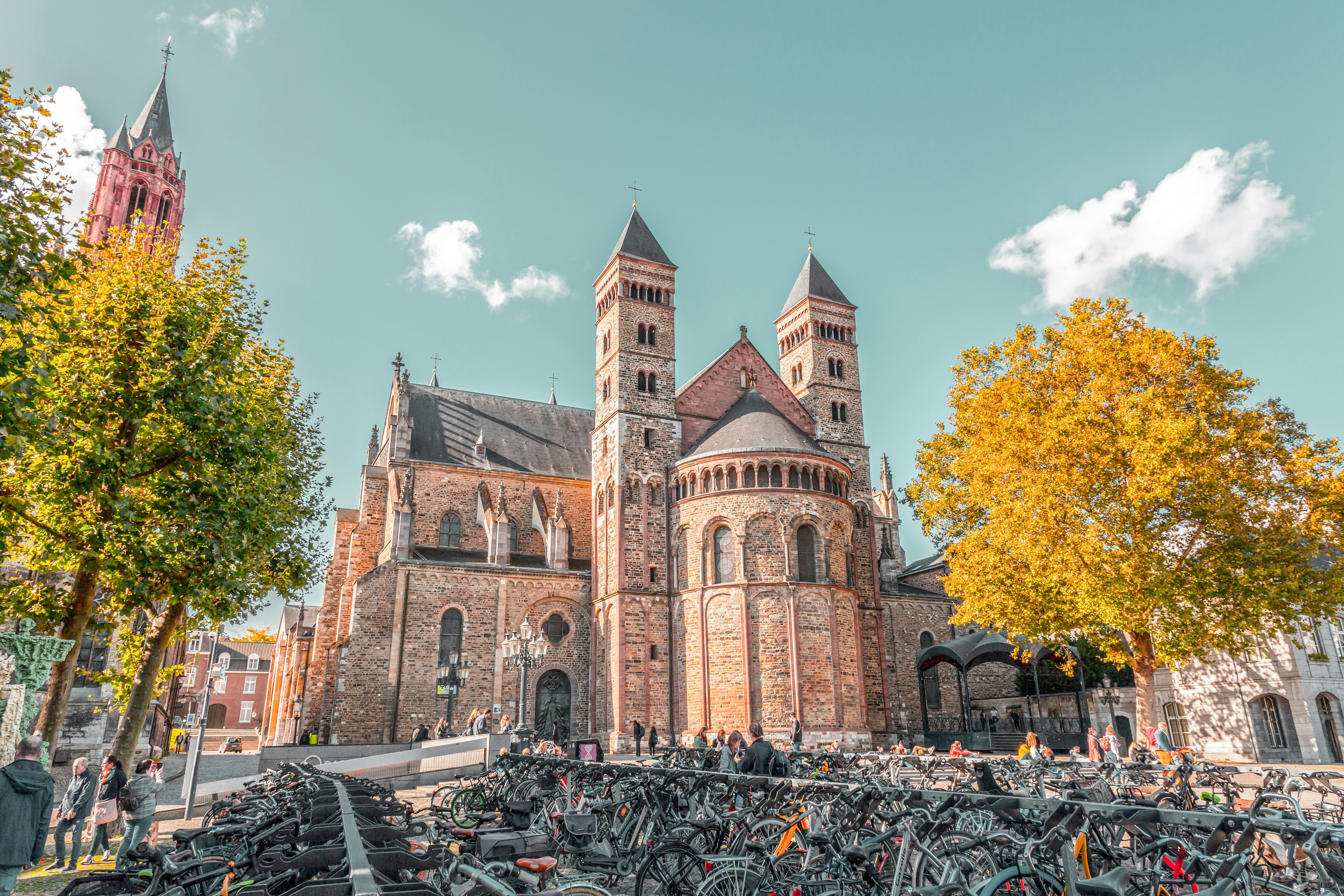Why Maastricht should be the next Dutch city on your must-see list
Jul 18, 2025 • 6 min read

The Vrijthof in Maastricht. Ivo Antonie de Rooij/Shutterstock
The shape of the Netherlands looks a little like a cartoon terrier scampering east. OK, you’ll need to squint quite a bit…but if you go with the idea, you’ll see its cute little front leg sticking down to the southeast. On the paw of this imaginary cartographic limb you’ll find Maastricht, synonymous with the treaty that established the European Union, but also one of the country’s oldest, most enjoyable yet least appreciated gem cities.
Once here, you’ll swap the manic cycle-dodging of busy Amsterdam streets for unhurried strolls on ancient city walls and unhassled drinks on convivial terraces. Instead of canals you’ll find a broad river with feeder millstreams. Instead of the 2.5 million people in greater Amsterdam’s metropolis, Maastricht has a population of barely 220,000, of which over 10% are students and around 60% of them international. There’s great food, a party vibe, underground discoveries, hefty fortifications, postindustrial imagination and, almost unique for the famously flat Netherlands, contours.
Sint Servaas basilica and the St. John Church. ColorMaker/Shutterstock
Maastricht’s best experiences
Whether above or below ground, here’s where to find the best of Maastricht in 2025.
Enjoy the Burgundian good life
Culturally, Maastricht embodies the character that the Dutch call Burgundian, a life-affirming love of living well. The passion for rich good food is variously expressed; traditional local zuurvlees (meaty Limburg stew) at Café Sjiek, humorously presented Belgian fare at Witloof (which will reopen on August 19), affordable old-school French comfort food at Le Bouchon d’En Face or cozy Michelin-starred dining at Au Coin des Bon Enfants with its option of full-on vegetarian gastronomy. A merry cafe-bar culture sees a plethora of buzzing terraces; places like Fretz on adorable little Sint-Amorsplein; tiny wine bar Via Mucca on quaint, pedestrianized Koestraat; classic brown bar In den Ouden Vogelstruys on Vrijthof; the riverside perch of Stadsbrowerij Maastricht brewery-cafe; and De Gouverneur with its book-thick menu of great beers.
Seek out the spiritual soul of the city
Maastricht’s bubbling Burgundian indulgence is balanced by a deep-seated Catholic piety, quite different from anything you’d find in post-Protestant Amsterdam. Join in by contributing to the blaze of candles that light a miraculous shrine-space within broodingly underlit Onze Lieve Vrouwebasiliek. That’s a memorable Mosan-Romanesque basilica-church, brought back to its antique brilliance by architect Pierre Cuypers of Rijksmuseum fame. Every seven years it attracts huge pilgrimage crowds: as many as 100,000 people for the June-July 2025 version.
Maastricht’s cafe- and tree-hemmed main square, Vrijthof, hosts boisterous Vastelaovend carnivals and the bumper concerts of local waltz-king André Rieu. However, visually it’s dominated by a bevy of church spire-towers. You can climb the 280 steps of St Janskerk’s ox-blood red tower to survey the city. The other towers crown Maastricht’s second Romanesque religious masterpiece, Sint Servaas basiliek, which houses the boggle-eyed gilded bust of Maastricht’s first bishop, Armenian-born St Servaas (Servatius), buried here in 384 AD.
Take quiet strolls by the old walls
Exploring the green areas and cobbled lanes around the Jeker mill stream uncovers charmingly peaceful corners and unexpected fragments of former city walls. Within the 1229 Helpoort stone gateway-tower, discover a mini-museum celebrating the many eras of city fortifications. Chunky sections of medieval wall continue west, where you can watch for herons on the grassy banks around Nieuwenhofpoortje. In Aldenhof Park a statue of D’Artagnan depicts the real-life musketeer, later mythologized by Alexandre Dumas, who died in 1673 while besieging Maastricht for Louis XIV's France.
Cut northeast past De Reek Watermill whose gently whooshing waterwheel creates a bass drone that counterpoints the elegant sounds of piano practice emanating from the Conservatorium music school. Near the interesting yet little heralded Natural History Museum, you can hear the mellow clunk of pétanque balls beneath mature plane trees of Grote Looiersstraat, an avenue that curves back towards the commercial center.
Hike the hills
Newsflash. Maastricht isn’t flat. At least, not quite. Some of the Netherlands’ prettiest hiking routes take to the hills from the sweet if almost over-quaint castle town of Valkenburg, just a 10-minute train ride east of Maastricht. And you don’t even have to go that far to find green undulations. Stroll 20 minutes south (1.5km/1 mile) from the old city center to find Fort St Pieter, a hefty hillside pentagon of 1701 fortress-earthworks. You can burrow inside with a guided tour. Or, without a guide, continue 1km (about half a mile) farther to Uitzichtpunt Sint Pietersberg where a free viewpoint platform is suspended dramatically above a big former quarry, now a curious land reclamation site with opal blue ponds.
Go deeper underground
Centuries of less visible quarrying have also created an incredible labyrinth of caves and tunnels beneath the southern hills. Over 80km (50 miles) survive, some used in times of war as bomb shelters, stores and resistance escape routes. Maastricht Underground leads various fascinating subterranean walking tours but do pre-book online. There’s a town-sized former Nato HQ that was an underground Cold War secret till 1992. The popular North Caves tour enters a WWII-era vault which protected national art treasures, including Rembrandt’s The Night Watch, from possible wartime destruction. Guides might briefly turn off the lights to reveal a blackness more intense than anything you’ve ever likely experienced. Don’t wander off: getting lost in these tunnels would likely be a death sentence. Zonneberg routes concentrate on Napoleonic history, with tunnels wide enough that a tour variant is possible by scooter. Another twist allows you to combine Zonneberg with a boat ride from central Maastricht, but you’ll still need to climb a hillside to the tunnel entrance.
Get inspired by the city's creativity
In a repurposed former factory, concert venue Muziekgieterij hosts wildly varying genres, ranging from metal-monsters Cradle of Filth to a Laurent Garnier-curated club night. It’s just one element of Sphinxkwartier, a massive regeneration of a former inner-city industrial zone named for the former Sphinx ceramics enterprise. In the outwardly banal Eiffel building, the 120m-long (393ft) Sphinxpassage visually tells the tale of how Maastricht became central in creating 20th-century toilet bowls. On the nearby former river-dock, Lumière is an inspired art house cinema with full-on graffiti-chic cafe-bar and an open-air film festival.
Many other related workshops and lifestyle projects invite visitors during the July Sphinx Open weekend. Elsewhere in Maastricht, other unexpected spaces to discover include a church turned into the brilliant bookshop-coffeehouse Boekhandel Dominicanen and an old fire station reworked in 1970s-retro style is now the laptop-friendly cafe-restaurant, Kantine.

Where to stay in Maastricht
Plentiful accommodation is dotted around the compact central area, and there’s plenty more near the train station. Prices are often barely half of what you’d pay in Amsterdam…except during the André Rieu concert season when you won’t find a bed for miles around. Atmospheric Kruisherenhotel is a top central choice in a revamped 15th-century monastery complex. Mid-range, high-service Hotel Derlon is on one of the livelier central squares and has a Roman surprise in its breakfast room: a veritable archaeological museum. The Social Hub sets you up with contemporary rooms in an imaginatively regenerated factory turned multi-purpose social space. Save money on sleep but not facilities at The Green Elephant, a luxury hostel with spa and sauna options. If money’s no object, out-of-town Château Neercanne combines history and indulgence in a gorgeous 1715 castle with Baroque gardens and a Michelin-starred restaurant.

How to pair a visit to Maastricht with a trip to Amsterdam
Distance-wise, Maastricht’s about as far as you can get from Amsterdam without leaving the Netherlands. However, fast trains take less than 2½ hours. As on all Dutch public transport, you can simply tap-in/tap-out with a contactless credit/debit card in which case the journey costs second/first class €31.20/53.04 (US$36/$61) each way. However, using the app of the main national rail provider, NS, can offer very significant savings on advance purchase, off-peak e-tickets (unchangeable date and travel-time window, no refunds) with Amsterdam-Maastricht for as little as €12.48 ($14).
Maastricht’s train station is in the appealing Wyck district on the east side of the River Maas. Walking to the old center takes around 15 minutes, almost the same time as by city bus.








